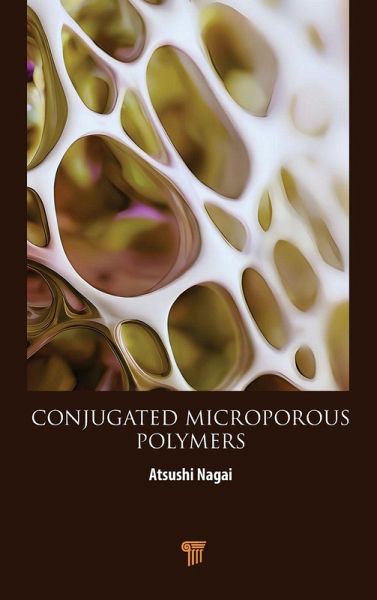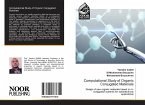Atsushi Nagai
Conjugated Microporous Polymers
Atsushi Nagai
Conjugated Microporous Polymers
- Gebundenes Buch
- Merkliste
- Auf die Merkliste
- Bewerten Bewerten
- Teilen
- Produkt teilen
- Produkterinnerung
- Produkterinnerung
This book summarizes the progress in the synthesis and design of CMPs and their applications in clean energy technologies such as hydrogen generation and storage, carbon dioxide adsorption and conversion, rechargeable batteries, supercapacitors, and photocatalytic H2 production.
Andere Kunden interessierten sich auch für
![Advanced Research on New Materials Based on Pi-Conjugated Molecules Advanced Research on New Materials Based on Pi-Conjugated Molecules]() Mohammed BouachrineAdvanced Research on New Materials Based on Pi-Conjugated Molecules49,99 €
Mohammed BouachrineAdvanced Research on New Materials Based on Pi-Conjugated Molecules49,99 €![Computational Study of Organic Conjugated Materials Computational Study of Organic Conjugated Materials]() Yassine sadikiComputational Study of Organic Conjugated Materials17,99 €
Yassine sadikiComputational Study of Organic Conjugated Materials17,99 €![Conjugated molecules for organic photovoltaic cells: DFT study Conjugated molecules for organic photovoltaic cells: DFT study]() Aziz El AlamyConjugated molecules for organic photovoltaic cells: DFT study27,99 €
Aziz El AlamyConjugated molecules for organic photovoltaic cells: DFT study27,99 €![Heterophase Polymerization Heterophase Polymerization]() Hugo HernandezHeterophase Polymerization200,99 €
Hugo HernandezHeterophase Polymerization200,99 €![Covalent Organic Frameworks Covalent Organic Frameworks]() Atsushi NagaiCovalent Organic Frameworks131,99 €
Atsushi NagaiCovalent Organic Frameworks131,99 €![Polymer Electrolyte Fuel Cells Polymer Electrolyte Fuel Cells]() Polymer Electrolyte Fuel Cells174,99 €
Polymer Electrolyte Fuel Cells174,99 €![Materials Chemistry Materials Chemistry]() Materials Chemistry202,99 €
Materials Chemistry202,99 €-
-
-
This book summarizes the progress in the synthesis and design of CMPs and their applications in clean energy technologies such as hydrogen generation and storage, carbon dioxide adsorption and conversion, rechargeable batteries, supercapacitors, and photocatalytic H2 production.
Hinweis: Dieser Artikel kann nur an eine deutsche Lieferadresse ausgeliefert werden.
Hinweis: Dieser Artikel kann nur an eine deutsche Lieferadresse ausgeliefert werden.
Produktdetails
- Produktdetails
- Verlag: Jenny Stanford Publishing
- Seitenzahl: 228
- Erscheinungstermin: 4. Juni 2025
- Englisch
- Abmessung: 229mm x 152mm
- ISBN-13: 9789815129663
- ISBN-10: 981512966X
- Artikelnr.: 73328987
- Herstellerkennzeichnung
- Libri GmbH
- Europaallee 1
- 36244 Bad Hersfeld
- gpsr@libri.de
- Verlag: Jenny Stanford Publishing
- Seitenzahl: 228
- Erscheinungstermin: 4. Juni 2025
- Englisch
- Abmessung: 229mm x 152mm
- ISBN-13: 9789815129663
- ISBN-10: 981512966X
- Artikelnr.: 73328987
- Herstellerkennzeichnung
- Libri GmbH
- Europaallee 1
- 36244 Bad Hersfeld
- gpsr@libri.de
Atsushi Nagai is a professor and the group leader of Next-Generation Energy Systems Group at Ensemble3 Center of Excellence, Warsaw, Poland. He obtained his PhD in the polymerization mechanism and polymerizable monomer design from Yamagata University, Japan, in 2005. He has more than a decade of experience as an assistant, visiting, and associate professor at Kyoto University, Japan (2008-2010), Institute for Molecular Science, Japan (2010-2017), University of Texas Southwestern, USA (2014-2015), Technical University of Delft, the Netherlands (2017-2020), and Toyohashi University of Technology, Japan (2021-2022). He has published more than 80 papers, 6 patents, and 5 book chapters, edited 2 books, and authored a textbook. His research interests include the design and synthesis of organic porous materials containing covalent organic frameworks and conjugated microporous polymers for various energy storage applications.
1. Porous Organic Materials
1.1. Porous Materials
1.2. Porous Organic Polymers
2. Synthetic and Structural Studies of CMPs
2.1. Design and Synthesis
2.2. Synthesis Routes
2.3. Control Over Porous Structure
2.4. Perspectives and Challenges
3. Surface Area and the Theory of Porous Materials
3.1. Introduction
3.2. Gas Sorption Theory
4. Gas Storage of CMPs
4.1. Natural Equilibrium
4.2. Greenhouse Gas Emissions
5. Heterogeneous CMP's Catalyst Applications
5.1. Introduction
5.2. Conjugated Microporous Polymers for Heterogeneous Catalysis
5.3. Heterogenous Organocatalysis
5.4. CMPs for Heterogeneous Photocatalytic Applications101
5.5. Conclusion and Perspective
6. CMP's Energy Storage Applications
6.1. Introduction
6.2. CMPs as Electrode for LIBs
6.3. CMPs as Electrode for SIBs
6.4. CMPs for Supercapacitors
6.5. Conclusion and Future Outlook
7. CMP's Semiconductor Applications
7.1. Porous Materials
7.2. Charge Transfer of Concept
7.3. Synthetic Porous Frameworks
7.4. Synthetic Building Frameworks
7.5. Functionalization of CMPs, MOFs, and COFs for Semiconductors
7.6. Theoretical Studies of CT Complex
7.7. Electrical Conductivity of CMPs, COFs, and MOFs
7.8. Prospect for CT Complex
7.9. Conclusion
1.1. Porous Materials
1.2. Porous Organic Polymers
2. Synthetic and Structural Studies of CMPs
2.1. Design and Synthesis
2.2. Synthesis Routes
2.3. Control Over Porous Structure
2.4. Perspectives and Challenges
3. Surface Area and the Theory of Porous Materials
3.1. Introduction
3.2. Gas Sorption Theory
4. Gas Storage of CMPs
4.1. Natural Equilibrium
4.2. Greenhouse Gas Emissions
5. Heterogeneous CMP's Catalyst Applications
5.1. Introduction
5.2. Conjugated Microporous Polymers for Heterogeneous Catalysis
5.3. Heterogenous Organocatalysis
5.4. CMPs for Heterogeneous Photocatalytic Applications101
5.5. Conclusion and Perspective
6. CMP's Energy Storage Applications
6.1. Introduction
6.2. CMPs as Electrode for LIBs
6.3. CMPs as Electrode for SIBs
6.4. CMPs for Supercapacitors
6.5. Conclusion and Future Outlook
7. CMP's Semiconductor Applications
7.1. Porous Materials
7.2. Charge Transfer of Concept
7.3. Synthetic Porous Frameworks
7.4. Synthetic Building Frameworks
7.5. Functionalization of CMPs, MOFs, and COFs for Semiconductors
7.6. Theoretical Studies of CT Complex
7.7. Electrical Conductivity of CMPs, COFs, and MOFs
7.8. Prospect for CT Complex
7.9. Conclusion
1. Porous Organic Materials
1.1. Porous Materials
1.2. Porous Organic Polymers
2. Synthetic and Structural Studies of CMPs
2.1. Design and Synthesis
2.2. Synthesis Routes
2.3. Control Over Porous Structure
2.4. Perspectives and Challenges
3. Surface Area and the Theory of Porous Materials
3.1. Introduction
3.2. Gas Sorption Theory
4. Gas Storage of CMPs
4.1. Natural Equilibrium
4.2. Greenhouse Gas Emissions
5. Heterogeneous CMP's Catalyst Applications
5.1. Introduction
5.2. Conjugated Microporous Polymers for Heterogeneous Catalysis
5.3. Heterogenous Organocatalysis
5.4. CMPs for Heterogeneous Photocatalytic Applications101
5.5. Conclusion and Perspective
6. CMP's Energy Storage Applications
6.1. Introduction
6.2. CMPs as Electrode for LIBs
6.3. CMPs as Electrode for SIBs
6.4. CMPs for Supercapacitors
6.5. Conclusion and Future Outlook
7. CMP's Semiconductor Applications
7.1. Porous Materials
7.2. Charge Transfer of Concept
7.3. Synthetic Porous Frameworks
7.4. Synthetic Building Frameworks
7.5. Functionalization of CMPs, MOFs, and COFs for Semiconductors
7.6. Theoretical Studies of CT Complex
7.7. Electrical Conductivity of CMPs, COFs, and MOFs
7.8. Prospect for CT Complex
7.9. Conclusion
1.1. Porous Materials
1.2. Porous Organic Polymers
2. Synthetic and Structural Studies of CMPs
2.1. Design and Synthesis
2.2. Synthesis Routes
2.3. Control Over Porous Structure
2.4. Perspectives and Challenges
3. Surface Area and the Theory of Porous Materials
3.1. Introduction
3.2. Gas Sorption Theory
4. Gas Storage of CMPs
4.1. Natural Equilibrium
4.2. Greenhouse Gas Emissions
5. Heterogeneous CMP's Catalyst Applications
5.1. Introduction
5.2. Conjugated Microporous Polymers for Heterogeneous Catalysis
5.3. Heterogenous Organocatalysis
5.4. CMPs for Heterogeneous Photocatalytic Applications101
5.5. Conclusion and Perspective
6. CMP's Energy Storage Applications
6.1. Introduction
6.2. CMPs as Electrode for LIBs
6.3. CMPs as Electrode for SIBs
6.4. CMPs for Supercapacitors
6.5. Conclusion and Future Outlook
7. CMP's Semiconductor Applications
7.1. Porous Materials
7.2. Charge Transfer of Concept
7.3. Synthetic Porous Frameworks
7.4. Synthetic Building Frameworks
7.5. Functionalization of CMPs, MOFs, and COFs for Semiconductors
7.6. Theoretical Studies of CT Complex
7.7. Electrical Conductivity of CMPs, COFs, and MOFs
7.8. Prospect for CT Complex
7.9. Conclusion








